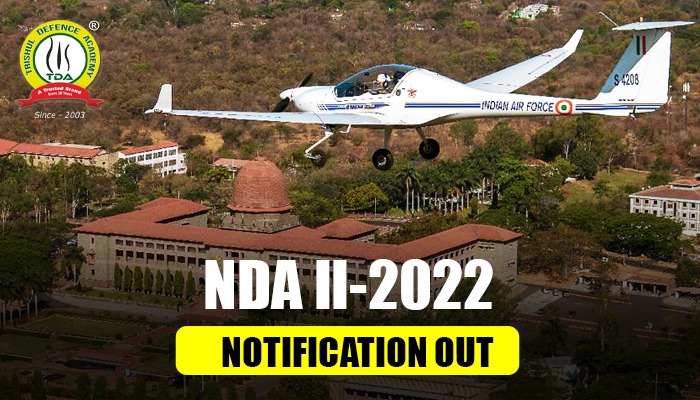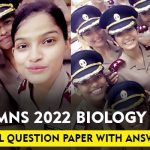WordPress database error: [Table './trishlldefenceac_def/wp_post_views' is marked as crashed and should be repaired]SELECT SUM(count) AS views
FROM wp_post_views
WHERE id IN (19953) AND type = 4
UPSC NDA 2 2022 Notification Released
UPSC Conducts National Defence Academy Entrance Exam Twice a Year.The Exams are Conducted in the Month of April (NDA -I) and September (NDA -II)Every Year.
This Year NDA -II will be Conducted on 4 Sep 2022 For which Notification is out by UPSC.The Important Dates for NDA -II 2022 are as follows:-
Form Start Date-18 May 2022
Form End Date– 7 June 2022
NDA -II 2022 Admit Card Release Date-Two weeks Before 4 Sep(August)
NDA-II Exam Date-4 Sep 2022
NDA -II Result-4-6 October 2022
NDA 2 2022 Application Fees
NDA Forms Can be filled up at www.upsc.gov.in with a fees of Rs100 For General Category however for SC/ST and For Girl Candidates the Form Remains Freei.e.no charges
NDA 2 2022 Eligibility Criteria
1.A Citizen of India
2.A Subject of Nepal
3.A Subject of Bhutan
4.A Tibetan refugee who came over to India before the 1st January, 1962 with the intention of permanently settling in India in other words a Tibetian Refugee
5.A person of Indian origin who has migrated from Pakistan, Burma, Sri Lanka and East African Countries of Kenya, Uganda, the United Republic of Tanzania, Zambia, Malawi, Zaire and Ethiopia or Vietnam with the intention of permanently settling in India.
Dates To Remember
Application Starts: 18th May 2022
Application End Date: 7th June 2022
Exam Date: 4th September 2022
Total Vaccancies
There is no Increment in Vacancies
TOTAL: 400
ARMY: 208 (10 for females)
NAVY: 42 (3 for females)
AIRFORCE: 120 (flying- 92) (2 for females) | GD tech- 18 (2 for females) | GD Non-tech-10 (2 for females)
Naval Academy: 30-Females Not Allowed
Age Limit Crieteria
Candiadates born on or between 2 Jan 2004 – 1 Jan 2007.Both Dates are Inclusive
Exam Pattern
Maths: 120 Questions
Science: 150 Questions
Marks: 300 marks For Maths and 600 Mark for GAT.Total 900 Marks
Time: 2 Hrs. 30 Min
NDA 2 2022 Educational Qualification
| Military Wing | Educational Qualification |
| Air Force Wing | 12th Class pass with Physics, Chemistry and Mathematics of the 10+2 pattern of School Education or equivalent conducted by a State Education Board or a University. |
| Naval Wing | 12th Class pass with Physics, Chemistry and Mathematics of the 10+2 pattern of School Education or equivalent conducted by a State Education Board or a University. |
| Army Wing | 12th Class pass of the 10+2 pattern of School Education or equivalent examination conducted by a State Education Board or a University |
NDA 2 2022 Selection Process :
Step 1: Written Exam: The first step involves the written exam..The exam involves papers of mathematics and general ability.Maths Consists of 120 Questions and Questions of General Ability are 150 Questions.
Step 2: SSB Interview:
- The second step involves the SSB Interview.
- Candidates who clear the written exam are called for the SSB Interview which tests them on their personality, physical fitness, group discussions and psychology.
NDA 2 2022 Exam Syllabus:
The NDA exam is divided into two papers namely Mathematics and General Ability Test (GAT).
Paper – I Mathematics Paper:
| Total Marks | 300 marks |
| Number of Questions | 120 |
| Marks Awarded for Correct Answer | 2.5 marks |
| Negative Marking | -0.83 marks |
| Exam Duration | 2.5 hours |

Approximate Questions Asked in NDA 1 2022 Paper wise and Topic Wise are attached below:-
Paper- II General Ability Test (GAT)

| Total Marks | 600 marks |
| Number of Questions | 150 |
| Number of Questions in English Section | 50 |
| Number of Questions in General Knowledge Section | 100 |
| Maximum Marks for English | 200 marks |
| Maximum Marks for General Knowledge | 400 marks |
| Marks for Correct Answer | 4 marks in both section |
| Negative Marking | -1.33 marks in both sections |
| Exam Duration | 2.5 hours |
Complete NDA 2 2022 Syllabus : Click Here to Check NDA 2 2022 Syllabus
In this Blog we are discussing the latest Syllabus of NDA 2 2022. NDA 2 2022 Form Notification has come on 18th May 2022 and Last date for Filling the Form is 7 June. Defence Aspirants wants to Know the Complete NDA Syllabus and thus Trishul Defence Academy Presents Complete NDA Scheme of Examination, Syllabus Of Examination. Kindly go Through The Blog Carefully..
SCHEME OF EXAMINATION
The subjects of the written examination, the time allowed and the maximum marks allotted to each subject will be as follows:—
| Subject | Code | Duration | Maximum Marks |
| Mathematics | 01 | 2½ Hours | 300 |
| General Ability Test | 02 | 2½ Hours | 600 |
| Total | 900 | ||
| SSB Test/Interview: | 900 | ||
- THE PAPERS IN ALLTHE SUBJECTS WILL CONSIST OF OBJECTIVE TYPE QUESTIONS ONLY. THE QUESTION PAPERS (TEST BOOKLETS) OF MATHEMATICS AND PART “B” OF GENERAL ABILITY TEST WILL BE SET BILINGUALLY IN HINDI AS WELL AS ENGLISH.
- In the question papers, wherever necessary, questions involving the metric system of Weights and Measures only will be set.
- Candidates must write the papers in their own hand. In no circumstances will they be allowed the help of a scribe to write answers for them.
- The Commission have discretion to fix qualifying marks in any or all the subjects at the examination.
- The candidates are not permitted to use calculator or Mathematical or logarithmic table for answering objective type papers (Test Booklets). They should not therefore, bring the same inside the Examination Hall.
SYLLABUS OF THE EXAMINATION
PAPER-I MATHEMATICS
(Code No. 01) (Maximum Marks-300)
ALGEBRA
- Concept of set, operations on sets, Venn
- De Morgan laws, Cartesian product, relation, equivalence
- Representation of real numbers on a line.
- Complex numbers—basic properties, modulus, argument, cube roots of
- Binary system of numbers.
- Conversion of a number in decimal system to binary system and vice-versa.
- Arithmetic, Geometric and Harmonic progressions.
- Quadratic equations with real coefficients.
- Solution of linear inequations of two variables by graphs.
- Permutation and Combination.
- Binomial theorem and its
- Logarithms and their
MATRICES AND DETERMINANTS :
- Types of matrices, operations on matrices.
- Determinant of a matrix, basic properties of determinants.
- Adjoint and inverse of a square matrix, Applications-Solution of a system of linear equations in two or three unknowns by Cramer’s rule and by Matrix
TRIGONOMETRY :
- Angles and their measures in degrees and in
- Trigonometrical ratios.
- Trigonometric identities Sum and difference formulae.
- Multiple and Sub-multiple angles.
- Inverse trigonometric functions.
- Applications-Height and distance, properties of
ANALYTICAL GEOMETRY OF TWO AND THREE DIMENSIONS:
- Rectangular Cartesian Coordinate
- Distance
- Equation of a line in various forms.
- Angle between two lines.
- Distance of a point from a line.
- Equation of a circle in standard and in general form.
- Standard forms of parabola, ellipse and hyperbola.
- Eccentricity and axis of a conic.
- Point in a three dimensional space, distance between two points.
- Direction Cosines and direction ratios.
- Equation two points.
- Direction Cosines and direction ratios.
- Equation of a plane and a line in various forms.
- Angle between two lines and angle between two planes.
- Equation of a
DIFFERENTIAL CALCULUS :
- Concept of a real valued function–domain, range and graph of a function.
- Composite functions, one to one, onto and inverse functions.
- Notion of limit, Standard limits—examples.
- Continuity of functions—examples, algebraic operations on continuous functions.
- Derivative of function at a point, geometrical and physical interpretation of a derivative—applications.
- Derivatives of sum, product and quotient of functions, derivative of a function with respect to another function, derivative of a composite function.
- Second order derivatives.
- Increasing and decreasing functions.
- Application of derivatives in problems of maxima and
INTEGRAL CALCULUS AND DIFFERENTIAL EQUATIONS :
- Integration as inverse of differentiation, integration by substitution and by parts, standard integrals involving algebraic expressions, trigonometric, exponential and hyperbolic functions. Evaluation of definite integrals—determination of areas of plane regions bounded by curves—applications.
- Definition of order and degree of a differential equation, formation of a differential equation by examples.
- General and particular solution of a differential equations, solution of first order and first degree differential equations of various types—examples. Application in problems of growth and decay.
VECTOR ALGEBRA:
- Vectors in two and three dimensions, magnitude and direction of a vector.
- Unit and null vectors, addition of vectors, scalar multiplication of a vector, scalar product or dot product of two vectors.
- Vector product or cross product of two vectors.
- Applications—work done by a force and moment of a force and in geometrical problems.
STATISTICS AND PROBABILITY :
- Statistics :
-
- Classification of data, Frequency distribution, cumulative frequency distribution—examples.
- Graphical representation—Histogram, Pie Chart, frequency polygon— examples.
- Measures of Central tendency—Mean, median and Variance and standard deviation—determination and comparison.
- Correlation and
- Probability:
-
- Random experiment, outcomes and associated sample space, events, mutually exclusive and exhaustive events, impossible and certain events.
- Union and Intersection of events.
- Complementary, elementary and composite events.
- Definition of probability—classical and statistical—examples.
- Elementary theorems on probability—simple problems.
- Conditional probability, Bayes’ theorem—simple problems.
- Random variable as function on a sample space.
- Binomial distribution, examples of random experiments giving rise to Binominal
PAPER-II GENERAL ABILITY TEST
(Code No. 02) (Maximum Marks—600)
Part ‘A’—ENGLISH (Maximum Marks—200)
The question paper in English will be designed to test the candidate’s understanding of English and workman like use of words. The syllabus covers various aspects like: Grammar and usage, vocabulary, comprehension and cohesion in extended text to test the candidate’s proficiency in English.
Part ‘B’—GENERAL KNOWLEDGE (Maximum Marks—400)
The question paper on General Knowledge will broadly cover the subjects: Physics, Chemistry, General Science, Social Studies, Geography and Current Events.
Section ‘A’ (Physics)
- Mechanical Properties of Fluid: Physical Properties and States of Matter, Mass, Weight, Volume, Density and Specific Gravity, Principle of Archimedes, Pressure Barometer.
- Mechanics: Motion of objects, Velocity and Acceleration, Newton’s Laws of Motion, Force and Momentum, Parallelogram of Forces, Stability and Equilibrium of bodies, Gravitation, elementary ideas of work, Power and Energy.
- Transfer of Heat: Effects of Heat, Measurement of Temperature and Heat, change of State and Latent Heat, Modes of transference of Heat.
- Sound & Waves: Sound waves and their properties, Simple musical instruments.
- Optics: Rectilinear propagation of Light, Reflection and refraction. Spherical mirrors and Lenses, Human
- Electrostatic & Electromagnetism: Natural and Artificial Magnets, Properties of a Magnet, Earth as a Magnet. Static and Current Electricity, conductors and Non- conductors, Ohm’s Law, Simple Electrical Circuits, Heating, Lighting and Magnetic effects of Current, Measurement of Electrical Power, Primary and Secondary Cells, Use of X-Rays.
- Miscellaneous: General Principles in the working of the following:
- Simple Pendulum, Simple Pulleys, Siphon, Levers, Balloon, Pumps, Hydrometer, Pressure Cooker, Thermos Flask, Gramophone, Telegraphs, Telephone, Periscope, Telescope, Microscope, Mariner’s Compass; Lightening Conductors, Safety Fuses.
Section ‘B’ (Chemistry)
- Physical and Chemical changes.
- Elements, Mixtures and Compounds, Symbols, Formulae and simple Chemical Equations, Law of Chemical Combination (excluding problems).
- Properties of Air and
- Preparation and Properties of Hydrogen, Oxygen, Nitrogen and Carbondioxide, Oxidation and Reduction.
- Acids, bases and salts.
- Carbon—different forms.
- Fertilizers—Natural and Artificial.
- Material used in the preparation of substances like Soap, Glass, Ink, Paper, Cement, Paints, Safety Matches and Gun-
- Elementary ideas about the structure of Atom, Atomic Equivalent and Molecular Weights, Valency.
Section ‘C’ (General Science)
- Difference between the living and non-living.
- Basis of Life—Cells, Protoplasms and Tissues.
- Growth and Reproduction in Plants and Animals.
- Elementary knowledge of Human Body and its important
- Common Epidemics, their causes and
- Food—Source of Energy for man.
- Constituents of food, Balanced Diet.
- The Solar System—Meteors and Comets, Eclipses.
- Achievements of Eminent Scientists.
Section ‘D’ (History, Freedom Movement etc.)
- A broad survey of Indian History, with emphasis on Culture and Civilisation.
- Freedom Movement in India.
- Elementary study of Indian Constitution and Administration.
- Elementary knowledge of Five Year Plans of India.
- Panchayati Raj, Co-operatives and Community Development.
- Bhoodan, Sarvodaya, National Integration and Welfare State, Basic Teachings of Mahatma Gandhi.
- Forces shaping the modern world; Renaissance, Exploration and Discovery; War of American Independence.
- French Revolution, Industrial Revolution and Russian Revolution.
- Impact of Science and Technology on Society.
- Concept of one World, United Nations, Panchsheel, Democracy, Socialism and Communism. Role of India in the present world.
Section ‘E’ (Geography)
- The Earth, its shape and size.
- Lattitudes and Longitudes, Concept of time.
- International Date Line.
- Movements of Earth and their
- Origin of Earth.
- Rocks and their classification; Weathering—Mechanical and Chemical, Earthquakes and Volcanoes.
- Ocean Currents and Tides Atmosphere and its composition; Temperature and Atmospheric Pressure, Planetary Winds, Cyclones and Anti-cyclones; Humidity; Condensation and Precipitation; Types of Climate, Major Natural regions of the World.
- Regional Geography of India—Climate, Natural vegetation. Mineral and Power resources; location and distribution of agricultural and Industrial activities. Important Sea ports and main sea, land and air routes of India. Main items of Imports and Exports of
Section ‘F’ (Current Events)
Knowledge of Important events that have happened in India in the recent years. Current important world events.
Prominent personalities—both Indian and International including those connected with cultural activities and sports.
NOTE : Out of maximum marks assigned to part ‘B’ of this paper, questions on Sections ‘A’, ‘B’, ‘C’, ‘D’, ‘E’ and ‘F’ will carry approximately 25%, 15%, 10%, 20%, 20% and 10% weightages respectively.
Trishul Defence Academy – Best NDA and SSB Interview Coaching

If you want to get full success with flying colours in the final important round of SSB Interview Join Trishul Defence Academy- Northern India’s #1 Defence Coaching Today.
Under the guidance of SSB Master Colonel Pankaj Mehrotra (Ex-NDA, Ex- IO) 11 34 SSB, Allahabad & 21 22 SSB Bhopal, prepare for each and every test of SSB with full expertise. Ranging from written, psychological or group tasks, with TDA you are determined for success
With the inspiration of Trishul’s founder Late Wing Commander Anoop Mehrotra Sir, we proudly announce admissions for the SSB interview preparation course for the academic session of 2022-23 Come join us today for the ultimate success in SSB.
Trishul Defence Academy announces admission for SSB course 2022-23 for defence aspirants who wish to join the Indian Armed Forces with flying colours of success in defence entrance exams. Under the guidance of TDA’s honorable Director, Colonel Pankaj Mehrotra Sir prepare for SSB with perfection.
Connect with Trishul Defence Academy for the latest updates, notifications.
Call and connect with us to book a seat for yourself for the upcoming batch of 2021-22. Special discount offer on booking at the earliest.
For any query/enquiry you can connect us via following ways: –
Get Latest Blog On – blog.trishuldefenceacademy.com
Facebook –https://www.facebook.com/trishuldefenceacademy
Twitter – https://twitter.com/trishuldefence
Address : Ground Floor, Gayatri Dham, Millan Tower, Civil Lines, Prayagraj, Uttar Pradesh 211001
Phone: 084000 83030
Jai Hind





